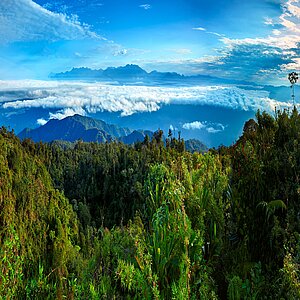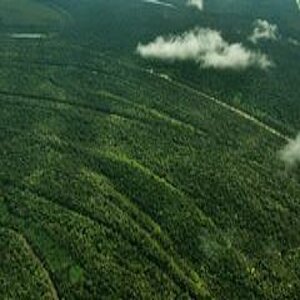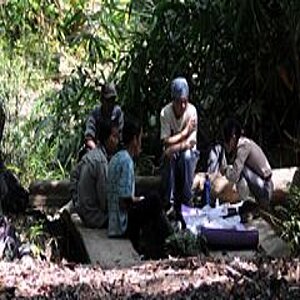Hope for Sumatran Tiger and Co.
A project in Indonesia will protect and restore one of the world’s most biodiverse, but also one of the most threatened rainforests. It gives hope for many endangered animal and plant species, such as Sumatran Tiger, Asian Elephant, Malayan Tapir, Storm's Stork and Ironwood as well as to the communities who depend on the forest for their livelihoods.
A project in Indonesia will protect and restore one of the world's most biodiverse, but also one of the most threatened rainforests. It gives hope for many endangered animal and plant species, such as Sumatran Tiger, Asian Elephant, Malayan Tapir, Storm's Stork and Ironwood as well as to the communities who depend on the forest for their livelihoods. With more than 7.5 Million Euros, the German Ministry of Environment (BMU) is supporting, via KfW Entwicklungsbank, the conservation of Harapan Rainforest, a 1,000 square kilometer area in the provinces of South Sumatra and Jambi on the Indonesian island of Sumatra. The project is part of the BMU's International Climate Initiative. It enables the Indonesian foundation Yayasan KEHI to restore degenerated habitats and to conserve the species-rich forest as part of a new partnership with the German nature conservation organisation NABU and its British BirdLife partner, the Royal Society for the Protection of Birds (RSPB). "This project demonstrates impressively, how climate protection and the conservation of biodiversity can work hand in hand", said the German Minister of Environment, Dr. Norbert Röttgen on the occasion of the official project launch in Germany. "With this project – one of the biggest under our International Climate Initiative – we will help to slow down the loss of forests in Indonesia and conserve Harapan Rainforest as a carbon store of global importance."
"We are thankful to the German Government for supporting such a unique project", said NABU President Olaf Tschimpke. "Harapan Rainforest is Indonesia's first area under a new type of forest management for ecosystem restoration. With this new type of forestry licence there is now the possibility to conserve one of the most species rich forests on the earth and its inhabitants as well as to contribute to the protection of our climate. This project could also be a model for other countries. We are happy, that we are among the pioneers in this internationally important project", Tschimpke added.
Indonesia holds about ten percent (90 million hectares) of the world's remaining tropical rainforests. Two thirds of these are classified as production forest. Under a business as usual scenario, the Indonesian government estimates that around 14 millions of hectares of forest could be lost or heavily damaged within the next 20 years, which would result in the emission of 2.8 billions of harmful carbon dioxide into the atmosphere. The new type of forestry licence, which was introduced in 2004, is for up to 100 years and requires the concession holder to conserve and restore the forest ecosystem. If applied more widely, this type of forest management could reduce carbon emissions significantly.
"The costs for reforestation, infrastructure development, management, protection and community development initiatives will be financed for the next four years via the KfW Entwicklungsbank", said Uwe Ohls, Senior Vice President Asia, of the KfW Entwicklungsbank. "This project will protect and restore this important rainforest, but also improve the livelihoods of communities in and around Harapan Rainforest", Ohls added.
Harapan Rainforest is managed by the non-for-profit foundation Yayasan KEHI. Yayasan KEHI was founded by a consortium of the nature conservation organizations Burung Indonesia, the RSPB and the NABU partner BirdLife International. The costs of managing Harapan Rainforest are considerable. In order to ensure the long-term financing of Harapan Rainforest, the consortium has set up a trust fund. The ultimate goal is to capitalize this trust fund with up to 40 million Euros.
Harapan Rainforest is a so-called Sundaic dry lowland rainforest, one of the most biodiverse, but also one of the most threatened rainforests on earth. From an initial 16 million hectares in 1900, a mere 400,000-600,000 hectares remain, the rest has already been destroyed by legal and illegal logging and conversion to oil palm or timber plantations. Harapan Rainforest is important for many species, including the critically endangered Sumatran tiger. It is estimated that up to 20 have their home in the area, out of a wild population of 100-300.
Rainforests are natural carbon dioxide sinks. Initial estimates show, that by conserving and restoring Harapan Rainforest around 10 to 15 millions of tons of carbon dioxide will be stored within the next 30 years. If the model was extended to other areas, the impact on Indonesia's carbon balance could be massive. Harapan Rainforest is therefore an important pilot project in the Indonesian strategy to reduce carbon emissions from deforestation emissions. Protecting and restoring Harapan Rainforest will contribute to the water regulation in the region and special projects are being put in place to support local communities in achieving a sustainable living. "Harapan" is the Indonesian word for "hope". This hope is not only shared by the more than 100 project staff on the ground but by conservationists around the world.
The link has been copied to the clipboard
Contact
IKI Office
Zukunft – Umwelt – Gesellschaft (ZUG) gGmbH
Stresemannstraße 69-71
10963 Berlin







